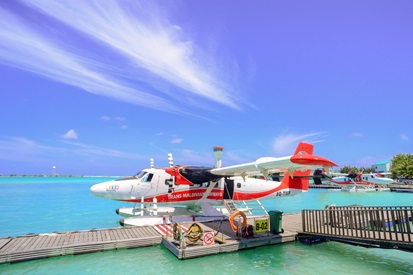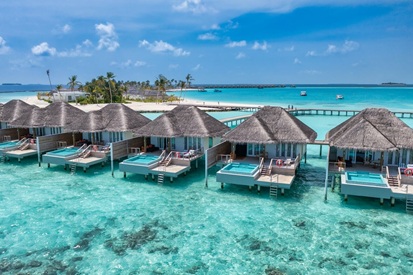

Maldives... The word conjures up images of heavenly beaches, azure lagoons, and overwater bungalows. But the true magic of this archipelago awaits beneath the ocean's surface. We're talking about manta rays—graceful giants whose encounters are among the most memorable experiences for many travelers.

Depositphotos
Mantas - the mysterious giants of the ocean
Manta rays are the largest members of the eagle ray family. Their enormous, wing-like fins silently cut through the water, creating the sensation of flight. Their size is impressive, yet they are completely harmless.
Manta rays were first described by the German zoologist Johann Walbaum in 1792. They are the only vertebrates on our planet to have three pairs of fully functional limbs.
Two species are most commonly found in the Maldives:
- Reef Manta. It's smaller (maximum 5.5 meters in wingspan), but this species is most often seen in coral reefs and in the bays of the Maldives. The Maldives archipelago is home to the world's largest reef manta population.
- Oceanic Manta. It is larger than the reef manta (individual specimens can reach up to 9 meters) and prefers the open ocean, but is also found near the Maldivian atolls.
Manta rays feed exclusively on plankton. They filter water through their gill filaments, passing it through their wide-open mouths. Their "horns" on their heads, or cephalic fins, help direct the flow of plankton-laden water directly into their mouths. Incidentally, "manta" means "blanket" in Spanish, which aptly describes their appearance.
Surprisingly, every manta ray has a unique pattern of spots on the underside of the body, like a fingerprint. This allows scientists to identify individual individuals and track their movements, behavior, and numbers.

Depositphotos
When and where to meet manta rays in the Maldives
The Maldives is one of the best places on the planet to meet mantas, thanks to its abundant food base and well-organized surveillance programs. Meetings are possible all year round, but there are certain seasons and places where the chances of seeing them are greatly increased.
The life of manta rays in the Maldives is governed by monsoon winds, which determine the movement of plankton:
- Southwest Monsoon (May to November). During this period, winds blow from the southwest, bringing plankton to the eastern sides of the atolls. This is the time when mantas gather in huge numbers in the bays and lagoons of the eastern sides to feast.
- Northeast Monsoon (December to April). During this period, winds change direction to the northeast, and plankton concentrates on the western sides of the atolls. Mantas move after their food.
Thus, for observing manta rays, you can choose a suitable location depending on the time of year.

Depositphotos
Best places to meet mantas in the Maldives
- Hanifaru Bay, Baa Atoll. This is an absolute gem and perhaps the most famous spot in the world for manta ray spotting. Hanifaru Bay is a protected marine area and part of a UNESCO Biosphere Reserve. During the southwest monsoon (especially from July to October), the bay's unique shape acts as a funnel, concentrating enormous volumes of plankton. Here, you can witness an incredible phenomenon—a "feeding vortex" or "manta cyclone"—when dozens, sometimes up to two hundred, manta rays circle in dense formations. Only snorkeling is permitted in Hanifaru Bay; diving is prohibited. Visits are strictly regulated, and advance permission is required.
- Dharavandhoo Corner, Baa Atoll. Another great spot on the atoll where manta rays gather between May and November.
- Ari Atoll. This atoll, particularly its southern part (South Ari Atoll), is also known as a year-round habitat for whale sharks, but manta rays are also frequent visitors, especially at the cleaning stations. Manta ray sightings are possible from May to November on the eastern side and from December to April on the western side. Popular dive sites include Rangali Madivaru (South Ari) and Fesdhoo Lagoon (North Ari).
- Lankan Manta Point, North Malé Atoll. A famous spot for diving and snorkeling with manta rays, especially between May and November.
- Raa Atoll. Manta rays can be seen in the waters of this atoll, particularly at the Sola Corner dive site, between December and April.
- Laamu Atoll. There are also good places, for example, Fushi Kandu and Hithadhoo Corner, where mantas can be met from May to November.

Depositphotos
Hotels for swimming with mantas
Discover hotels that offer the opportunity to swim surrounded by manta rays:
- Vilamendhoo Island Resort on Ari Atoll,
- Villa Park (Ex. Sun Island Resort and Spa) on Ari Atoll,
- Anantara Kihavah Villas on Baa Atoll,
- Bliss Dhigurah 3* on Ari Atoll,
- LUX* South Ari Atoll on Ari Atoll,
- Dusit Thani Maldives on Baa Atoll,
- Hotels on the local island Dharavandhoo in Baa Atoll, from where transfers to Hanifaru Bay are available.
The resort Four Seasons Resort Maldives at Landaa Giraavaru offers its guests a "Manta Ray On Call" service, which allows them to receive a special notification when manta rays are spotted near the hotel, take a short speedboat ride, and swim with them.
The special beauty of the Maldives is that you can meet manta rays both during specially organized excursions and while swimming with a mask and tube at the home reef.

Dusit Thani Maldives
Behavioral characteristics of mantas
Observation of mantas is not only a meeting but also an opportunity to witness their unique behavior:
- Feeding. As mentioned, the "feeding vortex" is a mesmerizing sight, where manta rays form spiral or chain formations to maximize plankton collection. They can perform "somersaults" or "backflips" underwater to stay within the food supply.
- Cleaning stations. These are specific areas of the reef where small cleaner fish remove parasites and dead skin from the manta rays' surfaces. Manta rays patiently hover or swim slowly above these stations, allowing the fish to do their work. This provides an excellent opportunity for divers and snorkelers to observe manta rays up close.
- Playful behavior. Manta rays often display curiosity and playfulness toward people. They may swim very close, circling, as if exploring unfamiliar objects.

Four Seasons Resort Maldives at Landaa Giraavaru
Ecology and conservation
Manta rays play a vital role in marine ecosystems and are a key ecotourism attraction in the Maldives. However, they are vulnerable to threats such as:
- accidental entanglement in fishing nets;
- ocean pollution;
- destruction of coral reefs and plankton sources;
- unsustainable tourism, particularly overcrowding, noise, and handling of manta rays can cause stress and aggression.
Manta conservation efforts are actively underway in the Maldives. Activists from the Maldives Manta Conservation Programme (MMCP), affiliated with the marine conservation charity The Manta Trust, are actively involved in research and protection of these creatures. They identify individuals by their spots, track their migrations, study their behavior, and work to establish new marine protected areas. Thanks to their efforts, Baa Atoll has become a UNESCO Biosphere Reserve and Hanifaru Bay a protected area.

Depositphotos
Safety rules while swimming with mantas
If you're lucky enough to encounter manta rays, remember these simple but important rules:
- Keep your distance and don't get too close to them (at least 3 meters).
- Never touch the animals. This can damage their protective mucus layer, cause stress, and disrupt their natural behavior.
- Avoid sudden movements and loud noises in the water.
- Do not use flash when taking photos or videos.
- Abide by the rules established by local authorities and dive centers, and follow your guide's instructions.
An encounter with manta rays in the Maldives is more than just another adventure. Therefore, if you're planning a trip to the Maldives, be sure to include a manta ray encounter in your itinerary.

Depositphotos
More articles
- Bali's Best Beach Clubs - 13 Luxury Oases
- Tips for tourists in Indonesia - how to avoid spoiled holidays
- Yoga Studios in Bali - where to catch Zen on the Island of the Gods
- Port Louis: All About Mauritius' Capital
- Seychelles Honeymoon Hotels: 9 Paradise Spots
- Bali's Best Eco-Hotels: Top 12 Spots
- Seychelles for outdoor activities - from diving to jungle trekking
- Why you can be deported from Bali - several main reasons
- Seychelles hotels with the best panoramic views
- UNESCO sites in Indonesia: temples, parks and other amazing places



